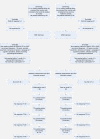Collaborative stepped care for anxiety disorders in primary care: aims and design of a randomized controlled trial
- PMID: 19737403
- PMCID: PMC2753326
- DOI: 10.1186/1472-6963-9-159
Collaborative stepped care for anxiety disorders in primary care: aims and design of a randomized controlled trial
Abstract
Background: Panic disorder (PD) and generalized anxiety disorder (GAD) are two of the most disabling and costly anxiety disorders seen in primary care. However, treatment quality of these disorders in primary care generally falls beneath the standard of international guidelines. Collaborative stepped care is recommended for improving treatment of anxiety disorders, but cost-effectiveness of such an intervention has not yet been assessed in primary care. This article describes the aims and design of a study that is currently underway. The aim of this study is to evaluate effects and costs of a collaborative stepped care approach in the primary care setting for patients with PD and GAD compared with care as usual.
Methods/design: The study is a two armed, cluster randomized controlled trial. Care managers and their primary care practices will be randomized to deliver either collaborative stepped care (CSC) or care as usual (CAU). In the CSC group a general practitioner, care manager and psychiatrist work together in a collaborative care framework. Stepped care is provided in three steps: 1) guided self-help, 2) cognitive behavioral therapy and 3) antidepressant medication. Primary care patients with a DSM-IV diagnosis of PD and/or GAD will be included. 134 completers are needed to attain sufficient power to show a clinically significant effect of 1/2 SD on the primary outcome measure, the Beck Anxiety Inventory (BAI). Data on anxiety symptoms, mental and physical health, quality of life, health resource use and productivity will be collected at baseline and after three, six, nine and twelve months.
Discussion: It is hypothesized that the collaborative stepped care intervention will be more cost-effective than care as usual. The pragmatic design of this study will enable the researchers to evaluate what is possible in real clinical practice, rather than under ideal circumstances. Many requirements for a high quality trial are being met. Results of this study will contribute to treatment options for GAD and PD in the primary care setting. Results will become available in 2011.
Trial registration: NTR1071.
Figures



References
-
- Buist-Bouwman MA, de Graaf R, Vollebergh WA, Alonso J, Bruffaerts R, Ormel J. Functional disability of mental disorders and comparison with physical disorders: a study among the general population of six European countries. Acta Psychiatr Scand. 2006;113:492–500. doi: 10.1111/j.1600-0447.2005.00684.x. - DOI - PubMed
-
- Wittchen HU, Kessler RC, Beesdo K, Krause P, Hofler M, Hoyer J. Generalized anxiety and depression in primary care: prevalence, recognition, and management. J Clin Psychiatry. 2002;63:24–34. - PubMed
Publication types
MeSH terms
Substances
LinkOut - more resources
Full Text Sources
Medical
Miscellaneous

